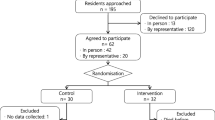Abstract
Objective: To identify determinants of PRN (as needed) drug use in nursing homes. Decisions about the use of these medications are made expressly by nursing home staff when general medical practitioners (GPs) prescribe medications for PRN use.
Method: Cross-sectional drug use data were collected during a 7-day window from 13 Australian nursing homes. Information was collected on the size, staffing-mix, number of visiting GPs, number of medication rounds, and mortality rates in each nursing home. Resident specific measures collected included age, gender, length of stay, recent hospitalisation and care needs.
Main outcome measures: The number of PRN orders prescribed per resident and the number of PRN doses given per week averaged over the number of PRN medications given at all in the seven-day period.
Results: Approximately 35% of medications were prescribed for PRN use. Higher PRN use was found for residents with the lower care needs, recent hospitalisation and more frequent doses of regularly scheduled medications. With increasing length of stay, PRN medication orders initially increased then declined but the number of doses given declined from admission. While some resident-specific characteristics did influence PRN drug use, the key determinant for PRN medication orders was the specific nursing home in which a resident lived. Resident age and gender were not determinants of PRN drug use.
Conclusion: The determinants of PRN drug use suggest that interventions to optimize PRN medications should target the care of individual residents, prescribing and the nursing home processes and policies that govern PRN drug use.
Similar content being viewed by others
References
Gurwitz JH, Soumerai SB, Avorn J. Improving medication prescribing and utilization in the nursing home. J Am Geriatr Soc 1990; 38: 542–52.
Macklin J. Issues in pharmaceutical drug use in Australia. Canberra: AGPS Publications, 1992 (http://www.health.gov.au/archive/nhs/documents/nhs/nhs17.pdf).
Schmidt I, Claesson CB, Westerholm B, Svarstad BL. Resident characteristics and organizational factors influencing the quality of drug use in Swedish nursing homes. Soc Sci Med 1998; 47: 961–71.
Robers PA. Extent of medication use in U.S. long-term-care facilities. Am J Hosp Pharm 1988; 45: 93–100.
Wayne SJ, Rhyne RL, Stratton SM. Longitudinal prescribing patterns in a nursing home population. J Am Geriatr Soc 1992; 40: 53–6.
Roberts M, King M, Stokes J, Lynne T, Bonner C, McCarthy S et al. Medication prescribing and administration in nursing homes. Age Ageing 1998; 27: 385–92.
Aycock EK. PRN drug use in nursing homes. Am J Hosp Pharm 1981; 38: 105.
Hughes CM, Lapane KL, Mor V. Influence of facility characteristics on use of antipsychotic medications in nursing homes. Med Care 2000; 38: 1164–73.
Shorr RI, Fought RL, Ray WA. Changes in antipsychotic drug use in nursing homes during implementation of the OBRA-87 regulations. J Am Med Assoc 1994; 271: 358–62.
Svarstad BL, Mount JK. Nursing home resources and tranquilizer use amoung the institutionalized elderly. J Am Geriatr Soc 1991; 39: 869–75.
Miller CA. PRN drugs. To give or not to give? Geriatr Nurs 1982; 3(Jan/Feb): 37–8.
Roberts MS, Stokes JA, King MA, Lynne TA, Purdie DM, Glasziou PP et al. Outcomes of a randomized controlled trial of a clinical pharmacy intervention in 52 nursing homes. Br J Clin Pharmacol 2001; 51: 257–65.
Aged and Community Care Division, Commonwealth Department of Human Services and Health. The Nursing Home Manual. Canberra: Commonwealth Department of Human Services and Health, 1995.
WHO Collaborating Centre for Drug Statistics Methodology. Anatomical Therapeutic Chemical (ATC) Classification Index. Oslo: World Health Organisation, 1994.
Duxbury J. An investigation into primary nursing and its effects on the nursing attitudes about and administration of prn night sedation. J Adv Nurs 1994; 19: 923–31.
Ingman SR, Lawson IR, Pierpaoli PG, Blake P. A survey of the prescribing and administration of drugs in a long term care institution for the elderly. J Am Geriatr Soc 1975; 23: 309–16.
Author information
Authors and Affiliations
Rights and permissions
About this article
Cite this article
Stokes, J.A., Purdie, D.M. & Roberts, M.S. Factors influencing PRN medication use in nursing homes. Pharm World Sci 26, 148–154 (2004). https://doi.org/10.1023/B:PHAR.0000026803.89436.a8
Issue Date:
DOI: https://doi.org/10.1023/B:PHAR.0000026803.89436.a8



